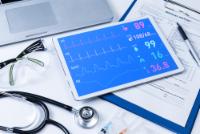Submitted by Tamala Sammons, M.A., CCC-SLP, Therapy Resource, Flagstone, Pennant, Sunstone, Milestone, Endura, Monument
 Vital signs are the objective measurements of temperature, pulse, respirations, and blood pressure as a clinical means to assess general health. Additionally, many include Pain and Gait Speed as the fifth and sixth vital signs.
Vital signs are the objective measurements of temperature, pulse, respirations, and blood pressure as a clinical means to assess general health. Additionally, many include Pain and Gait Speed as the fifth and sixth vital signs.
Vital signs are critical indicators of patient status, both at rest and during exercise/activity.
Therapists treat patients with many complicating conditions, such as:
- Respiratory conditions — pneumonia, COPD/chronic bronchitis, emphysema, asthma, atelectasis, etc.
- Cardiovascular conditions — CHF, hypertension, etc.
- Metabolic conditions — renal failure, diabetes, etc.
- Infection conditions — sepsis; Systemic Inflammatory Response Syndrome (SIRS), etc.
Taking consistent vital sign measurements will help ensure therapists have good data related to respiratory function, cardiovascular function, endurance, and a patient’s ability to tolerate functional activity.
As clinicians, it’s not only important to take vital signs, but also measure them against exercise/activity. In other words, vitals should be taken:
- Before the exercise (to establish a baseline);
- 6 to 8 minutes in the exercise; and
- 5 minutes after the exercise (recovery).
This information will allow clinicians to determine if target heart rates are being attained, any changes in condition, and/or if treatment adjustments need to be made, etc.
Consistent vital sign measurements also help detect medical condition changes. For example:
Sepsis early warning signs (these changes need to be reported immediately):
- Temperature higher than 100.4° F or lower than 96.8° F
- Heart rate greater than 90 beats per minute
- Respirations greater than 20 breaths per minute
Respiratory rehab considerations:
- A resting HR > 100 bpm is a relative indicator of patient instability.
- If lower than 90%, there is an inadequate oxygen supply, and less than 70% is life-threatening.
- Normal resting respiratory rate is 12-20 breaths per minute. “Normal” respiratory rate for an individual with pulmonary disease may fall outside these parameters. It is important to establish what is “normal” for each patient. Respiratory rate needs to be monitored before, during and after exercise.
Using vital signs to determine exercise termination:
- Significant blood pressure changes
- o BP>200/110
- Lightheadedness; BP drops >20 mmHg
- No more than an increase of 20mm Hg with activity
- Oxygen saturation <90%
- Severe shortness of breath
- Noticeable change in heart rhythm
It’s important to know the normal ranges for each vital sign along with considerations for an aging population. Additionally, it’s also important to know what medications patients are taking and if those medications may interfere with vital sign measurements.
For example:
- The medicine digoxin used for heart failure and blood pressure medicines called beta-blockers may cause the pulse to slow.
- Diuretics (water pills) can cause low blood pressure, most often when changing body position too quickly.
Take time to ensure every member of the Therapy team is taking vital signs consistently and throughout treatment sessions as recommended. Consider hosting a training lab if any skills need to be refreshed. Ensure team members have access to vital sign equipment (consider vital sign kits for each team member).
For more information on the details of vital signs, please refer to the Vital Signs POSTette, Pain Management POSTette, and Clincally Complex POSTette.
For training tools, check out these resources:
• Training video on taking blood pressure: https://www.youtube.com/watch?v=UGOoeqSo_ws
• Training video on all vital signs: https://www.youtube.com/watch?v=JpGuSxDQ8js
• LMS video available on Vital Signs: How to Measure Vital Signs REL-PAC-0-HMVS 1 hour
